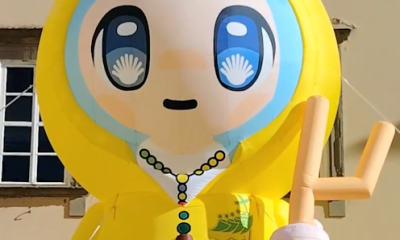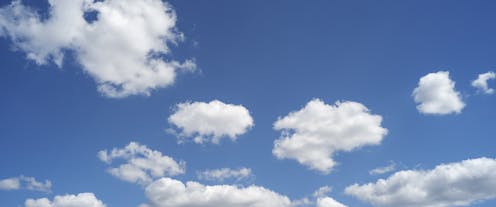Light at the blue end of the rainbow is scattered more efficiently than the other colors. shomos uddin/Moment via Getty Images
Curious Kids is a series for children of all ages. If you have a question you’d like an expert to answer, send it to CuriousKidsUS@theconversation.com.
Why is the sky blue? – Mariana A-E., age 11, Tucson, Arizona
You might think that explaining why the sky is blue would be kind of simple. But even a brief explanation of it requires a lot of science. The colors of everything you see are produced in different ways. Some of those colors are explained with physics, others by my own field of chemistry.
The nitrogen and oxygen that you are breathing right now are made up of very small particles called molecules. A molecule of nitrogen or oxygen is really, really small. Each molecule is only about 0.4 nanometers, or 16 billionths of an inch. It would take 250,000 nitrogen molecules to equal the width of one strand of your hair. You can think of the molecules as behaving like very tiny balls that constantly bounce around.
When sunlight travels through the atmosphere, it passes between lots of those teensy nitrogen and oxygen molecules. Sometimes the light runs right into one of them.
In short, the sky looks blue because the blue portion of sunlight is much more likely to bounce off the molecules in the atmosphere than the other colors of light.
Tennis balls and marbles
Now, picture the nitrogen and oxygen molecules as tennis balls and the light as heaps of marbles.
When one of those light marbles hits a nitrogen or oxygen tennis ball, the tennis ball “eats” the marble and then very quickly spits it back out again, but in a random direction. That process is what physicists call scattering.
It was around 1870 when the British physicist John William Strutt, better known as Lord Rayleigh, first found an explanation for why the sky is blue: Blue light from the Sun is scattered the most when it passes through the atmosphere. His discovery is why the scientific term for this effect is called Rayleigh scattering.
The other gases in the atmosphere can be really important too, such as the effects of carbon dioxide or methane on the global climate. But they have only a very small effect on the color of the sky.
If there were no scattering, the sky would be dark like it is on the Moon, which does not have an atmosphere.
The Moon’s sky isn’t blue.
peepo/E+ via Getty Images
A rainbow represents all the different components that make up sunlight. As that light passes through the water droplets suspended in the air, it is broken up into the component colors called the visible spectrum – red, orange, yellow, green, blue, indigo and violet, more easily remembered as ROY G. BIV.
Roy G. Biv.
hiroyuki nakai/Moment via Getty Images
Light at the blue end of the rainbow is scattered more efficiently than the other colors. It is as if the tennis balls are very selective in terms of which marbles they eat, and they prefer the blue ones over the other colors.
The result is that the blue light is scattered across the sky so you see blue everywhere on sunny days. The rest of the colors mainly travel straight through the atmosphere.
Redder when the Sun sets and rises
Of course, the sky is not always blue.
And Rayleigh scattering also explains why the sky tends to be reddish when the Sun is close to the horizon – at sunrise and sunset.
There’s a scientific explanation for why red and orange streaks stretch aross the sky at dawn or twilight.
Elenakirey/iStock via Getty Images Plus
When the Sun is near the horizon, its light passes through a lot more of the atmosphere to reach the Earth’s surface than when it is directly overhead. The blue and green light is scattered so well that you can hardly see it. The sky is colored, instead, with red and orange light.
Colors mean a lot to us in so many different ways. Understanding the science behind colors and expressing ourselves through art with colors have been important for humans for our entire recorded history. That’s something to keep in mind as you decide what color shirt to wear tomorrow morning.
NASA’s Space Place explains why the sky is blue.
Hello, curious kids! Do you have a question you’d like an expert to answer? Ask an adult to send your question to CuriousKidsUS@theconversation.com. Please tell us your name, age and the city where you live.
And since curiosity has no age limit – adults, let us know what you’re wondering, too. We won’t be able to answer every question, but we will do our best.
Daniel Freedman does not work for, consult, own shares in or receive funding from any company or organization that would benefit from this article, and has disclosed no relevant affiliations beyond their academic appointment.













